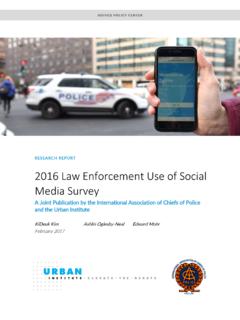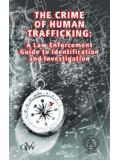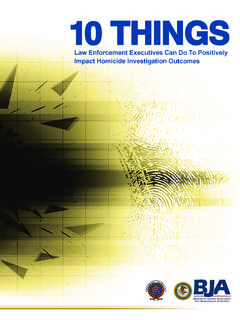Transcription of Law Enforcement’s Leadership Role in Juvenile …
1 INTERNATIONAL ASSOCIATION OF CHIEFS OF POLICE. Law Enforcement's Leadership Role in Juvenile Justice reform Actionable Recommendations for Practice & Policy July 2014. Law Enforcement's Leadership Role in Juvenile Justice reform Actionable Recommendations for Practice & Policy July 2014. IACP National Summit on Law Enforcement Leadership in Juvenile Justice September 25-26, 2013. with support from the John D. and Catherine T. MacArthur Foundation Prepared for the International Association of Chiefs of Police by Anna Bahney, Ryan Daugirda, John Firman, Aviva Kurash, and Kate Rhudy. The preparation of this document was supported by the John D. and Catherine T. MacArthur Foundation. Anyone may use the content of this publication as is for educational purposes as often and for as many people as wished. All we ask is that you identify the material as being the property of IACP. If you want to use this publication for commercial purposes in print, electronic, or any other medium, you need our permission.
2 If you want to alter the content or form for any purposes, educational or not, you will also need to request our permission. Acknowledgements T he International Association of Chiefs of Police would like to recognize contributors to this report. First, thank you to the John D. and Catherine T. MacArthur (WI) Police Department Chief of Police Edward Flynn, Spokane (WA) Police Department Chief of Police Frank Straub, Sausalito (CA) Police Department Chief of Police Foundation for including the law enforcement Jennifer Tejada, and Institute for the Study & Practice of community in their vision for Juvenile justice reform . Nonviolence Executive Director Teny Gross. We are especially grateful to Director of Justice reform Laurie Garduque and Program Officer Patrick Griffin for Thanks also to our MacArthur Foundation Resource their steadfast guidance and friendship. Center partners National Center for Mental Health and Juvenile Justice Director Joseph Cocozza, Robert Second, we are especially grateful to Office of F.
3 Kennedy Children's Action Corps President & CEO. Juvenile Justice and Delinquency (OJJDP) Prevention Ed Kelley, National Juvenile Defender Center Executive Administrator Robert Listenbee and his staff for their Director Patricia Puritz, and Vera Institute of Justice continual support of IACP Juvenile justice programs and Center on Youth Justice Director Annie Salsich who for lending counsel on this initiative. have graciously assisted us throughout this initiative and participated in a summit plenary session. Thank you to current IACP President Yost Zakhary (2013- 14) and past IACP Presidents Craig Steckler (2012- Additionally, the IACP would like to thank the summit 13) and Walter McNeil (2011-12) for their continued planning committee (see Appendix I) and the project Leadership and vision for Juvenile justice initiatives at advisory group for all of their work and assistance, in the IACP. addition to our breakout group facilitators who kept us focused: Bellingham (WA) Police Department Chief Thank you to New Haven (CT) Police Department Chief of of Police (retired) Randy Carroll, Falls Church (VA).
4 Police and Chair of the IACP's Juvenile Justice and Child Police Department Chief of Police Mary Gavin, Slaton Protection Committee, Dean Esserman, for providing Associates LLC Co-Owner Elaine Deck, and IACP staff opening remarks during lunch and for his unwavering members Kim Kohlhepp, and Michael Rizzo. dedication and passion for Juvenile justice issues. Of critical importantance, we thank the participants Thank you to our keynote speaker Erica Garcia, whose who attended the symposium and worked so diligently incredible story brought a standing ovation, and to to fashion the recommendations into a cogent action Montgomery County (MD) Youth Violence Prevention piece for IACP and the profession. Each participant was Coordinator Luis Cardona and Metropolitan (DC) chosen for his or her work and commitment to this Police Department Officer Andres Marcucci for their critical topic. Each participant contributed a unique involvement in Erica's life. This initiative would and important perspective.
5 We hope that we have be exceedingly more difficult without dedicated synthesized and conveyed their contributions faithfully professionals like you throughout the country. and accurately in this report. We're also appreciative of our panel discussion speakers: In recognition of their efforts, we have acknowledged former East Palo Alto (CA) Police Department Chief of each summit participant at the end of this report in Police and current Director of the Office of Community Appendix II. We also have acknowledged IACP project Oriented Policing Services Ronald Davis, Milwaukee staff in Appendix III. Acknowledgements iii iv IACP NATIONAL SUMMIT ON LAW ENFORCEMENT Leadership IN Juvenile JUSTICE. Table of Contents Acknowledgements .. iii Preface .. vii Executive Summary .. xi Summit Overview .. 1. Recommendations for Practice & Policy .. 5. (1) Making Juvenile Justice a Priority within Law Enforcement Agencies .. 5. (2) Building Partnerships among Law Enforcement, Youth & Their Families.
6 6. (3) Collaboration & Information Sharing .. 7. (4) Promoting Alternatives to Arrest, Court Referral & Detention .. 8. (5) Expanding Data Collection & Promising Initiatives .. 9. (6) Pathways to School Completion .. 9. (7) Responding to Youth with Behavioral Health Conditions & Trauma Histories .. 11. (8) Amplifying Law Enforcement's Advocacy on Juvenile Justice reform .. 11. Highlights from the Summit Deliberations .. 13. Making Juvenile Justice a Priority within Law Enforcement Agencies .. 13. Building Partnerships among Law Enforcement, Youth & Their Families .. 18. Collaboration & Information Sharing .. 22. Promoting Alternatives to Arrest, Court Referral & Detention .. 27. Expanding Data Collection & Promising Initiatives .. 31. Balancing the Benefits of Proven Programs with Encouraging Innovation .. 31. Pathways to School Completion .. 36. Responding to Youth with Behavioral Health Conditions & Trauma Histories .. 41. Amplifying Law Enforcement's Advocacy on Juvenile Justice reform .
7 45. Conclusion .. 47. Appendix I: Summit Advisors .. A-1. Appendix II: Summit Participants .. A-3. Appendix III: Project Staff .. A-7. Table of Contents v List of Promising Practices Profiles Erica's Story: How the Continued Interest of a Patrol Officer and a Caseworker Turned One Young Person's Life Around .. ix Articulating Juvenile Justice Priorities through Revised Protocols: SRO Guidelines in Battle Ground, Washington .. 16. The Pennsylvania DMC Youth-Law Enforcement Curriculum .. 21. Juvenile Information Sharing in Hawaii .. 25. Cambridge Safety Net Initiative: Collaboration on Prevention, Intervention & Diversion .. 26. Development of a Police Risk Assessment Instrument for Juvenile Diversion & Detention Decisions .. 29. Juvenile Assessment, Diversion & Citation in Lieu of Arrest in Miami-Dade County .. 30. Milwaukee Police Using Data to Identify Prolific Juvenile Offenders, Develop Intervention Strategies & Measure Outcomes .. 32. Evidence-Based Policing in Philadelphia: Understanding What Works, How Much Works, Where it Works & When it Works.
8 33. St. Paul Police Using Data to Reduce Racial & Ethnic Disparities .. 34. A Triad Model of School-Based Policing: SROs as Teachers, Counselors & Law Enforcement Officers .. 38. Community-Based Strategies to Combat Truancy in Louisiana & Georgia .. 39. Denver's Intergovernmental Agreement on School Discipline: Collaboration among the Police, School System & Community .. 40. Crisis Intervention Teams for Youth in Utah .. 44. Law Enforcement Leadership in Juvenile Justice: Agency, Community & Beyond .. 46. vi IACP NATIONAL SUMMIT ON LAW ENFORCEMENT Leadership IN Juvenile JUSTICE. Preface A n officer encounters a 13-year-old boy during the school day at a local skateboard park and discovers that the boy is chronically truant. placements across the United States1 more than in any other developed nation the treatment of Juvenile offenders has attracted significant policy, research, and fiscal scrutiny and ultimately the concern of lawmakers After being reported as a runaway, a 15-year-old girl and politicians.
9 Is in a park with a group of older youth that includes known drug offenders. A police officer on patrol finds When economists examined the Juvenile court system her. in Chicago, for example, they found that incarcerating a young person not only reduces the chance of that A school resource officer breaks up a fight between two individual earning a high school diploma (and thereby 12-year-old middle school boys. reduces their future individual success and economic Panicked foster parents call the police when a 16-year- value to society), it also increases the likelihood that old schizophrenic boy in their care threatens their person will commit more The economists daughter with a knife. concluded that the $6 billion the United States currently spends on Juvenile corrections each year Police officers are usually the first contact that young and the average cost of about $88,000 for a youth's people have with the Juvenile justice system. And 12-month stay in corrections could be much better yet in many communities, law enforcement leaders spent on strategies that maintain public safety but are have not been part of the discussion on Juvenile both cheaper and better for the young For justice reform and the development of policies and example, day and evening reporting centers can be practices addressing youth.
10 Sometimes it is because an effective alternative to incarceration for many non- they may not see their agency as part of the Juvenile violent offenders. justice system. However, it is often because others in the community working with young people schools, The need for Juvenile justice reform has become an issue service providers, legal professionals and others have that many policymakers across the political spectrum not embraced their involvement. The National Summit can agree on and that mainstream media outlets on Law Enforcement Leadership in Juvenile Justice was designed as a way to bridge that divide. 1. Office of Juvenile Justice and Delinquency Prevention. (2013). Juveniles in Residential Placement, 2010. The need for Juvenile justice reform is gaining This figure does not include youth held in widespread visibility as increased attention is directed federal facilities and adult prisons and jails. It also excludes those at the high costs and low efficacy of youth incarceration housed in facilities that are exclusively for drug or mental health treatment of for abused and neglected children.














